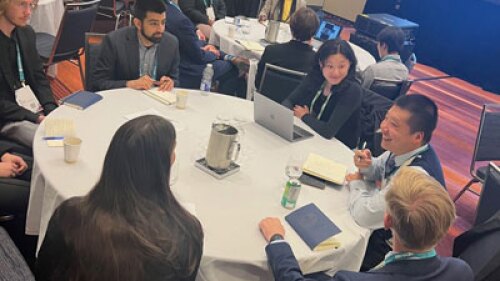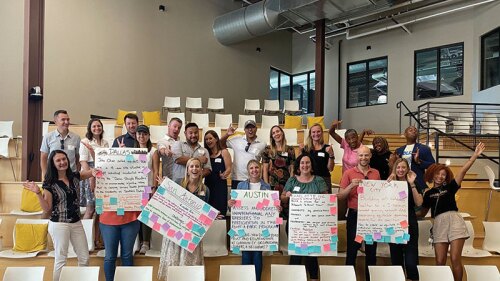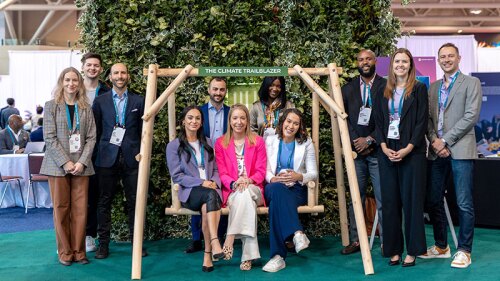At UDR Inc., a publicly traded apartment real estate investment trust (REIT), the management decided to take a different approach to corporate giving. Instead of the top executives picking causes, the 1,300-employees are given three days a year to use in any charitable way they choose and make recommendations for worthy projects, UDR chief executive officer Thomas W. Toomey said at the 2017 ULI Spring Meeting in Seattle.
“We’re not telling them what to do, but offering them time and a say in where the money goes,” said Toomey, incoming ULI global chairman, during a panel titled “Leading through Philanthropy.”
The panel discussion, moderated by Wendy Rowden, president of 42nd Street Development Corporation, focused on the challenges facing industry executives interested in taking a leadership role in philanthropy while continuing to run a business and, in many cases, raise a family. In trying to find the balance, tough choices have to be made, panelists said.
“One of hardest things is to say no,” said Lizanne Galbreath, managing director of Galbreath & Company. “It requires the ability to be disciplined on how you want to spend time, which is such a limited resource.”
The process often starts with identifying a charity that touches you in a personal way, Galbreath said. She chose to focus on her home community in Connecticut, which led her to get involved with the Fairfield County’s Community Foundation.
“Philanthropy, I think, is a lot about your own passion,” Galbreath said. “If you’re not passionate about it, it will wear you out.”
Milestone Communications chief executive Leonard Forkas started Hopecam in 2002, when his nine-year-old son was diagnosed with leukemia. Hopecam uses webcams to connect children undergoing treatment for cancer with their friends and family.
Forkas started raising money for the cause by running ultra-marathons and triathlons. “What I discovered was that my friends would pay me to suffer,” he said.
But he soon discovered that charity involves reaching out—that you cannot do it alone.
“I learned one thing: when you set a big goal, you need to ask for help. You have to ask everyone you know to support you, and you have to be humble,” Forkas said. “People want to help. People want to support you. You just have to be able to prove to them that the resources they are giving, whether time or capital, you’re putting them to good use.”
For Toomey, the analysis includes examining your ability to make an impact and exactly what you are willing to give. “It narrows down to one question: Am I going to give time or money?” Toomey said, “because you only have so much of each.”
Toomey gives money to support causes, but he is more selective about where he puts his time. One of his focuses is the Oregon State University Foundation, which helps offset the decline in state funding for the university.
“I started out with, I really like people and I like the cause,” Toomey said. “And you just spend more and more time on it, and it takes over to the point where you say, I can really help, I can make a difference.”
Volunteers must also determine what skills they can offer a charity, panelists said. Not everyone wants to be a fundraiser. Rowden realized her business skills and strategic visioning could help; many not-for-profits are led by executives with a background in social services, not business, she said.
“I think it is a realistic assessment of what you bring to the table,” Galbreath said. She found her background in governance, bylaws, accountability, and budgets was a valuable commodity. Not-for-profits “don’t want [boards] to just write the checks. They want to see the results,” she said.
Success in philanthropy requires many different skill sets, panelists said. “You have to show results and have to show impact,” Forkas said. “It’s storytelling. People are moved by the stories of how these people’s lives have changed.”
Finding more volunteers and getting more people involved are among the constant challenges, panelists said. That includes trying to get millennials, the next generation of leaders, involved in charity work. “They don’t have time,” Galbreath said. “They have the skills but don’t have bandwidth.” The key is to be “very specific about what you want them to do” and get involved around a specific skill set, she said.
All the panelists spoke about ways in which working for charity has changed their approach to business. Toomey said working on not-for-profit boards broadened his approach and made him sensitive to a different pace of accomplishing goals.
In working for charity, “you lead by bringing a community of people together and getting them to interact,” Toomey said. “It changes your management style to a more conducive, community-driven cause, and that’s different from running a business.”
Burnout is a constant problem in philanthropy, panelists said. The Oregon State University Foundation has a sunset clause that requires board members to leave after 12 years.
“When there is a sunset, people really pick up the pace,” Toomey said. Many people stay too long, and their engagement levels drop, even if they are still giving financially. Knowing when to leave is important, he said.
“When you ask yourself, ‘Am I fired up about going, or does it feel like an appointment on the calendar I have to go to?’ you’ll know,” he said.
But panel members also spoke about the rewards—the many unmeasurable returns—of their volunteer work.
“The more you give to something, the more you jump in, the more you get back,” Galbreath said.



